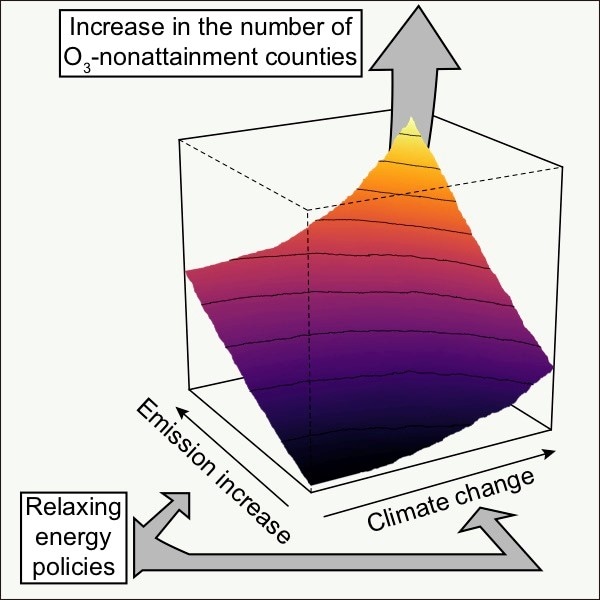Nov 6 2019
The Trump administration rolled back a U.S. climate change and energy policy called the Clean Power Plan in June 2019. The policy, first instated in 2015, aimed to limit power plants' carbon emissions.

In addition to the potential impacts on climate change, researchers reporting October 25 in the journal One Earth find that relaxing U.S. energy regulations would lower air quality by increasing emissions of health-damaging ozone. Their research suggests that with the combination of loosened regulations and a warming climate, 22 more U.S. counties would fail to meet the current ozone safety standard in 2050.
"Past research has focused mostly on the link between energy policies and greenhouse gas emissions," says first author Huizhong Shen of the Georgia Institute of Technology in Atlanta. "Through our study, we hope to point out the impact of energy policies on air quality, which tends to be overlooked."
Unlike ozone in the upper atmosphere, which shields the Earth from space radiation, ground-level ozone is harmful to animals, plants, and humans at high concentrations. It can damage our respiratory functions and reduce crop yields. In the past few decades, regulations have prompted significant reductions in ground-level ozone. However, it remains one of the most difficult air pollutants to manage.
Ozone is formed when nitrogen oxide gasses emitted from vehicles and factories react with volatile organic compounds in the air. "Ozone is a secondary pollutant," Shen says. "This means it's not emitted but formed in the air. Consequently, we can't regulate it by simply cutting off its emitters, because it doesn't have any. We need strict emission policies that cut other pollutants in order to reduce ozone."
The safety standard for ground-level ozone in the U.S. is 0.070 ppm. Currently, there are more than 120 million people living in areas with ozone concentrations exceeding that level.
Shen and his team created a computer model to simulate how relaxing energy policies would affect ozone levels through 2050. In their scenario, they assumed that several U.S. energy policies, the Clean Power Plan, Production Tax Credit, Investment Tax Credit, and the Corporate Average Fuel Economy standards on cars were eased.
"We chose this subset of energy policies not only because there have been many discussions around them but also because they target the power sector and the transportation sector," says coauthor Yufei Li of the Georgia Institute of Technology. "They are the two largest energy consumers and polluters in the country."
The team found that relaxing energy policies would add 6.5 percent more nitrogen oxides--ozone precursors--into the air compared to the scenario with the current policies still in place.
When the team took climate change into consideration, the effect on ozone precursor emissions was even more substantial. A warmer climate will encourage the release of volatile organic compounds--another ozone precursor--by plants. The study found that the synergistic effects of relaxed energy policies and climate change would cause 17 to 22 more U.S. counties to exceed the ozone safety standard in 2050. This represents a 63 to 81 percent increase in failing counties compared to the scenario of continued energy policies and no climate change. "We used an integrated model that considered many factors, such as potential changes in resource use and economic development," Li says. "It helps us make more accurate predictions and link policy to pollution."
Relaxing energy policies would reverse a current trend of decreasing ground-level ozone. "Uncertainty in science, especially when it comes to climate change or energy policy, plays a huge role in affecting legislations," Li says. "Lobbyists and politicians tend to use these uncertainties and emphasize the extremes to argue for their personal interests. As scientists, we want to speak with data and present only what the data shows us," he says.